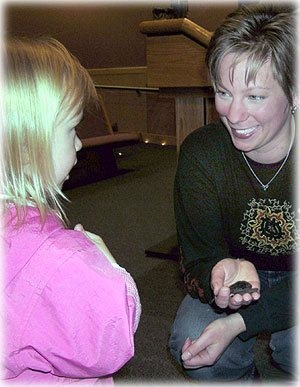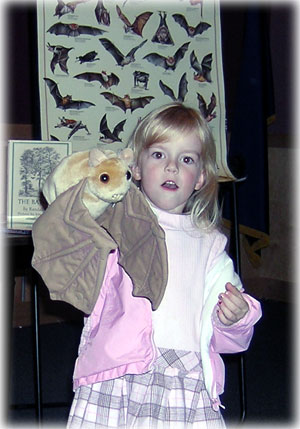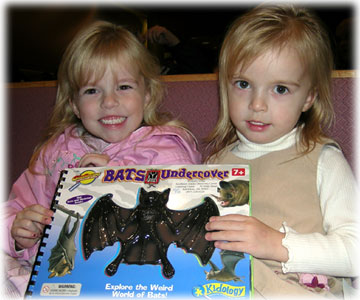 By Elizabeth Flom October 19, 2005
Rose, with a love for and an interest in bats for over ten years, is simply batty for bats. A Natural Resources expert, she has worked with the New Jersey Department of Fish and Game on various bat research projects. In this hour-long Friday Night Insight program, Rose presented an informative and educational presentation, "Bat Chat", which included a slide show, accompanied with audio examples, on bats commonly found in Ketchikan. She also explained and dispelled the most common myths about bats. The "Bat Chat" presentation began with a look at the flight skills of the bat - which is the only mammal that is a true flyer. Bats are able to fly because of their specialized wings that are made of tough skin and "fingers" that spread and support their wings. Of the nearly 1,000 species of bats, all bats belong to one of two main groups - the megachiroptera (megabat) or the microchiroptera (microbat). Megabats are fruit-eating bats that live in tropical areas and there are nearly 800 species of Microbats, forty-two of which live in the United States and Canada... and yes, right here in Ketchikan. Ketchikan has a population of five different species known by the common names of Little Brown Myotis, Silver-Haired Bat, Long-Legged Myotis, Keen's Myotis and California Myotis. Rose had a Little Brown Myotis that had found a home in Ketchikan during the program for the audience to touch and view. If you haven't seen bats in Ketchikan, try looking up. Bats are frequently seen south of Ketchikan, and around dusk it's not unusual to look up and see them flying overhead 14-miles north of the city. Bats are surprisingly small in size, ranging from the smallest known mammal the Bumblebee bat that weighs less than a penny. Most North American bats weigh no more than two nickels. However small these amazing creatures are, these bats none-the-less are vitally important to life.
Bats do help us in many ways said Rose. Some of the ways Ketchikan bats help are by decreasing the insect population. A single brown bat can impressively catch in excess of 600 mosquitoes an hour. Rose noted that bats also help by pollinating plants as well as by dropping seeds in flight which produce new plants and trees. The floors of bat caves also supply us with bat droppings called guano, which is used for fertilizer. And in the area of health, Rose said scientists studying bats are finding more ways to assist the blind in moving about independently, and the Vampire Bat may someday provide a new medicine that will help people with heart conditions. "An Introduction to Echolocation" slide show also captivated the audience as great bat calls screeched throughout the auditorium. Bats use this method of sensory perception - seeing with sound - to orient themselves to their surroundings, detect obstacles, communicate with others, and find food. In echolocation a series of short, high-pitched sounds are emitted by an animal and these sounds then travel out away from the bat and then bounce off objects and surfaces in the bat's path creating an echo. The echo returns to the bat, giving it a sense about what's in its path. It was explained that echolocation is used by most microbats. However, all bats do not produce the same types of sounds or calls. Interestingly, it was point out that a human could not detect the frequency of these bat sounds. Even at high speeds, bats have a good sense of where they are going using echolocation. A bat can determine an object's size, shape, direction, distance and motion using echolocation. This system is so accurate that bats can detect insects the size of gnats and objects as fine as human hair and... no, they won't get tangled in your hair. Rose said bats are much to smart to fly into hair. Bats flying into people's hair is just one of many bat myths. The bats in Ketchikan and elsewhere are not a threat to humans - but humans are the biggest threat to bats. Their natural predators in the wild include the eagle, hawk, owl, falcon, raccoons, wildcats, and snakes. Without predators, the bat colony would not be healthy said Rose. Surprisingly mother bats produce only one baby bat per year. A baby bat, called a pup, when born is 1/3 the size of its mother and are usually born in large colonies where thousands of pups can be found squeezed together hanging from the ceiling of a cave. Being squeezed or crowded together keeps the pups warm and safe. With all these pups together in such large numbers, Rose said a mother bat must use smell and the ability to recognize the cry of her pup in order to locate her baby in the colony. After several months, a pup is able to fly and hunt alone. Until then it relies on its mother's milk for food.
Rose brought the evening to an end with a question and answer session. Some of the young audience members asked Rose such questions as: Do bats have sharp teeth? and Why do bats have wings? Rose answered, bats do have sharp teeth so they can chew up bugs that have hard crunchy shells and bats have wings so they can fly. In response to the question asking if bats hibernate, Rose answered, yes they do. Rose also had a variety of books on display relating to the bat species. One book that children found particularly interesting displayed the anatomy of the bat. The hand held bat puppets were another eye-catcher for the young. Every Friday evening from 7 to 8 PM from October through April, the Southeast Alaska Discovery Center at 50 Main Street presents free audiovisual and speaker programs in their theater. The next Friday Night Insight Program, "SPIDERMANIA", is scheduled for October 21. If you are interested in spiders, Faith Duncan, a Ketchikan Naturalist with an eye for spiders, will give an interactive presentation, which will include slides, on arachnids (spiders). According to the Southeast Alaska Discovery Center, by the end of the show, you will be able to tell the difference between a web spinning spider and a non-spinning one and distinguish between species of Alaskan spiders. You will learn where to find spiders and, most importantly, how to safely remove spiders from your home. The family oriented event for
Halloween, "HAUNTED RAINFOREST", is scheduled for October
28th. You are invited by the Discovery Center to "Walk through
the dimly-lit Rainforest and look for Sasquatch. Then watch out
for the Kushtaka in the Native Traditions Room. After you see
the Devilfish in the Ecosystems Room, be sure to go to the Natural
Resources Room and ask the Gold Miners' ghosts if they have found
any gold." The Discovery Center will also have other fun
things to do including crafts, games and other scary discoveries. On the Web:
living in Ketchikan, Alaska. Publish A Letter on SitNews Read Letters/Opinions Submit A Letter to the Editor
|
||||


